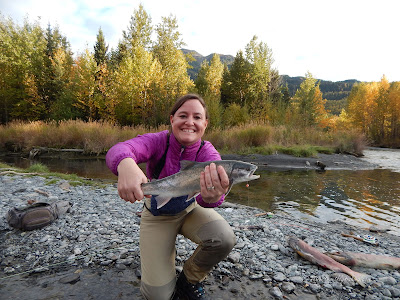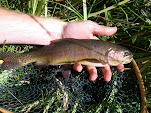The last few years for me have been marked by some of the best and busiest times of my life. During this time, I finally started my career as a fisheries biologist for the Washington Department of Wildlife, met my wonderful wife and started Graduate School at the University of Washington. To a large extent fishing has taken a back seat during this time, as has my search for native trout. However, this is not to say that I haven't been working with fish. Since starting my Masters degree program, I have been very involved with native trout and currently I am right in the midst of a project looking at the interactions between native resident Coastal Rainbow Trout and Steelhead. As these are two life history forms of the same species (Oncorhynchus mykiss), this will help to tease apart the relationship between these fish.
 |
| Research time |
 |
| A native Coastal Rainbow for the study |
The project is occurring on two rivers Olympic Peninsula rivers that have seen precipitous declines in their Steelhead returns in the last two decades, with lows in the 10's of fish (lowest years had 3 and 6 fish respectively). Due to this a restoration program was initiated 1998 (
http://www.lltk.org/rebuilding-populations/hcsp/summary) leading to some improvements in Steelhead abundance. While Steelhead returns have been relatively low in the watershed, the resident Rainbow Trout population appears to be healthy, making unclear what role Rainbow Trout may play in the success of the restoration.
 |
| Study River A |
 |
| Study River B |
As both watersheds have natural waterfalls that bar all anadromous fish from the upper reaches, where resident fish are the sole inhabitants. We are interested in a) if the these resident fish are passing downstream over the falls b) whether they still may have the ability to migrate out to sea and c) the food web interactions and growth patterns of fish both above and below the falls. To do so we are using a mark recapture study where we are catching fish via hook and line and electrofishing, tagging them with PIT (Passive Integrated Transponder) Tags, which allow us to identify individual fish and detect fish at antenna arrays near the mouths of the rivers. This allows us to see who is staying and who is going.
 |
| At the PIT Tag Antenna Array |
While tagging the fish we also collect a fin clip (for DNA analysis), a scale samples (to determine age and growth patterns), a diet sample (food web interactions) and length and weight.
 |
| Streamside sampling gear |
I am aiming to wrap up work on this project in late spring of 2016, so updates will be forthcoming. Needless to say this post is long, long overdue, and I hope to post more in the future.

































